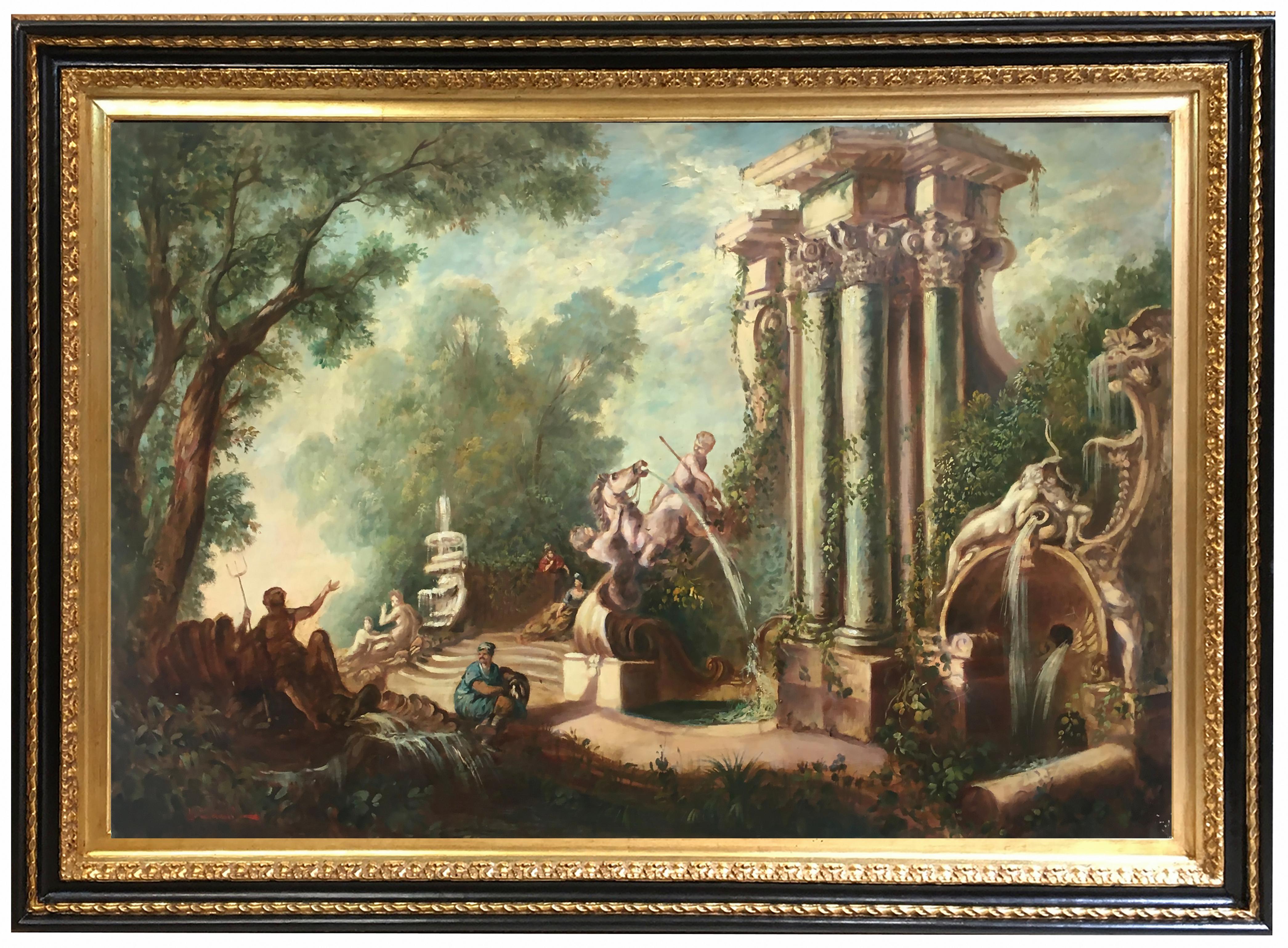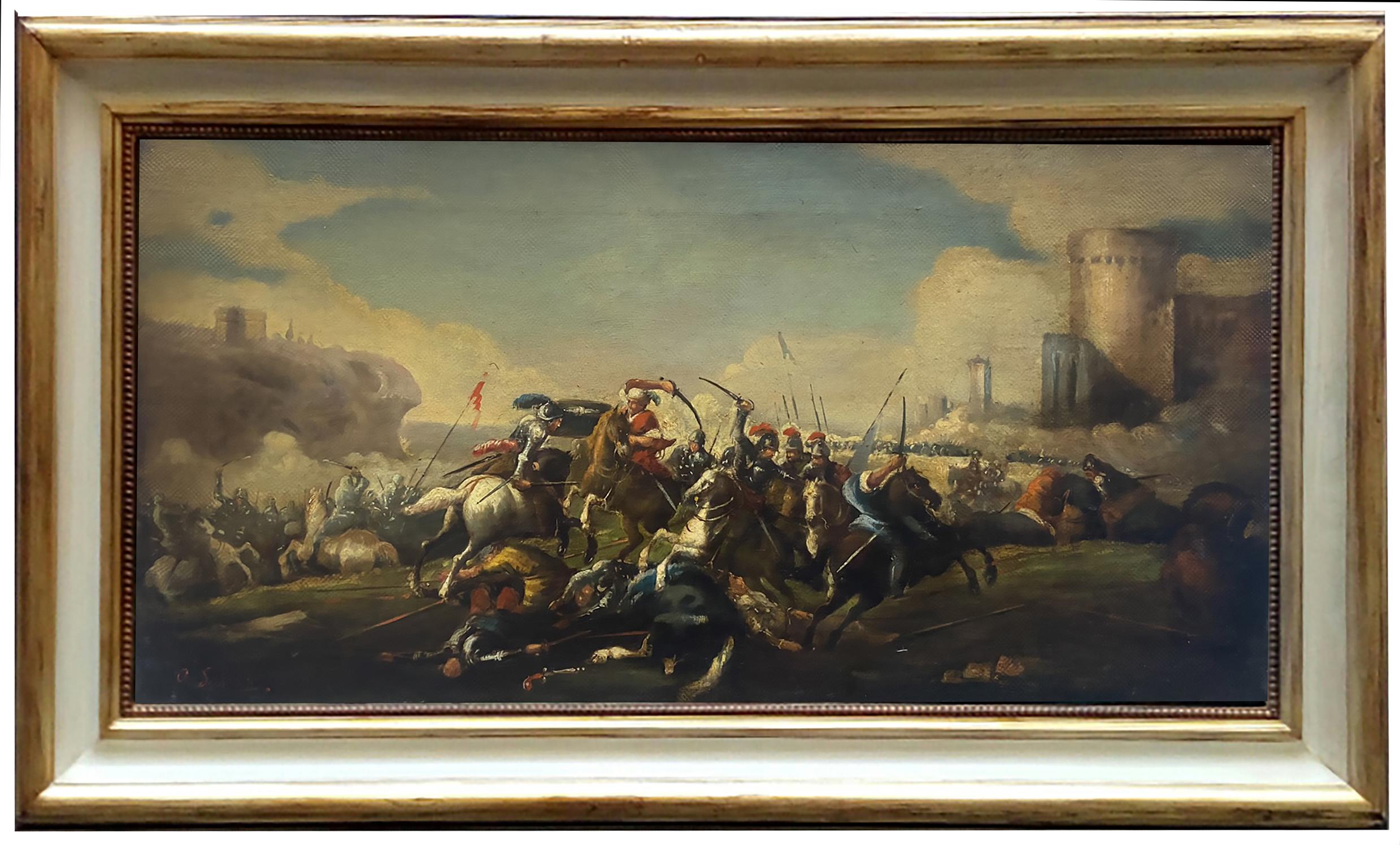Items Similar to 16th Century Parnassus Biagio Pupini called Biagio delle Lame Muses Oil on Panel
Want more images or videos?
Request additional images or videos from the seller
1 of 9
Biagio Pupini16th Century Parnassus Biagio Pupini called Biagio delle Lame Muses Oil on Panel
About the Item
This painting (in an excellent state of conservation and of fine executive workmanship, attests to the enormous
luck of Raphael's inventions in the years following his death: in fact it is clearly inspired by the famous fresco of Parnassusdone for Julius II in the Vatican.
The first thing that catches the eye is the not secondary role given to the landscape, which in Sanzio's painting is described in detail, but it is still a background to the scenemain: here, as if passing from a zoomed in to a wide angle, our painter dilates them distances between bystanders and indulges in the description of the fifth of nature, with a remarkable
sensitivity. We see it both in the subtle tonal changes of the bank from which the waterfall descends to give a certain depth to the representation, as in the specious and detailed workmanship with which the crackling fronds are returned, leafy leaves, brush-tip, with the pigment clearer on the tips to also return the reflections of the lumen.
In the
central group changes the pose of the god of the arts and almost all of the bystanders are invented on the second
slowly, the group on the right a presents variations in the garments but, on the whole, rather follows Parnassus faithfully, while the invention of the figures on the left is new to close symmetrically the composition.
The author of the sub judice table declines the prototype in key less grandiose and noble, lighter and more sweetened than the grandeur and majesty that expire by the protagonists of the Vatican fresco, softening the movements also due to the more subtle proportions and a certain simplification of the forms, which we find in the anatomies, in the physiognomics that recur without many variations from character to character - also the harbingers of a precise attributive proposal - in the course of the geometric-shaped cloths. Just these characters of gentle formal balance, display pleasantness, sweet eurythmy of the forms captured with a certain naturalness lead to place our table in the Bolognese area, and specifically in the art of Biagio Pupini.
From Sanzio Biagio Pupini took up the idea of the figure standing in the center and the others arranged symmetrically at the sides, in poses that respond to confer harmony and coherence to the representation. Already in this work we can grasp affinity with Parnassus. in the shoes of the somewhat geometric folds concluded by the sharp contour line, in the anatomy of the Child with the detachments of the muscles somewhat simplified, in the detailed way in which the hair is restored, as in the somatic ones (see the one in profile).
Even more handheld responses in a contemporary Nativity of the Pinacoteca Nazionale di Bologna in the soft folds where the light flows gently from the shape elongated, but above all in the features, here at the limit of congruence with those of the figurines of our table: see the Greek nose with the rounded tip, small mouth, chin a little protruding and elongated almond-shaped eyes, with a pin-pointed iris. It also occurs, again, a remarkable sensitivity in the restitution of nature, especially in the foliage rendered with the brush-tip strokes imbued with matter. Recurring physiognomies and anatomies in a table coeval see the little corniche of Jesus and the profile of Saint Catherine, with her hands somewhat simplified, the feet with well delineated phalanges and a slow pouring rendering of the reflections of the lumen on the hair.
They are characters of style, immersed in an atmosphere of golden classicism, which will leave the placed in the subsequent works to a greater formal abstraction, which is expressed in a more drawing clearer, more rigid and geometric cloths, stereotyped physiognomies, an insistent comparison of the lights that with deeper shadows and a statuary prominence of the figures, as we can see in the Sant 'Orsaia with the companions of the church of San Giacomo which is also one of the last known works by Biagio Pupini. In that year the artist was elected Massaro of the four arts in Bologna: not since 1551
plus his name in the documents, an indication of his disappearance.
From the comparisons proposed here, therefore, this Parnassus is not only to be attributed to Biagio Pupini, called Biagio dalle Lame, but is to be dated in the central phase of his career, which is then the apical point, around 1530 c.a, after the beginning of the collaboration with Girolamo da Carpi.
The paintings and works of art published here are my exclusive property and therefore are always available to be viewed, by appointment, in my exhibition sites located in Sanremo and Brescia.
This item , like all our objects, is sold accompanied by a photographic certificate FIMA of authenticity and lawful origin; this document identifies the object by adding more value to the article.
We take care and personally organize the packaging and shipping of our items with insurance all over the world.
Mr. Riccardo Moneghini
Art Historian
- Creator:Biagio Pupini (1511 - 1551)
- Dimensions:Height: 22.84 in (58 cm)Width: 28.75 in (73 cm)Depth: 1.19 in (3 cm)
- Medium:
- Movement & Style:
- Period:
- Condition:
- Gallery Location:Sanremo, IT
- Reference Number:1stDibs: LU1510211034342
About the Seller
5.0
Vetted Seller
These experienced sellers undergo a comprehensive evaluation by our team of in-house experts.
Established in 2013
1stDibs seller since 2021
Typical response time: <1 hour
- ShippingRetrieving quote...Ships From: Sanremo, Italy
- Return PolicyA return for this item may be initiated within 7 days of delivery.
More From This SellerView All
- 17th Century Darius' Family with Alexander Magnus Roman School Oil on CanvasLocated in Sanremo, ITPainting oil on canvas, measuring 78 x 110 unframed and 97 x 122 cm with coeval frame depicting the family of Darius with Alexander the Great, from the Roman school of the second hal...Category
Mid-17th Century Italian School Figurative Paintings
MaterialsCanvas, Oil
- 18th Holy Family Italian School Virgin and Child Oil on Canvas Blue Purple WhiteLocated in Sanremo, ITDelicate and caring Madonna with child, oil on copper, measuring 23 x 16 cm without frame and 32 x 25 cm with frame. Sweet colors and intimate attitudes for this painting that posse...Category
Mid-18th Century Italian School Figurative Paintings
MaterialsCopper
- 17th Century Myth of Diana and Ataeon Francesco Solimena Oil on Canvas Blu RedBy Francesco SolimenaLocated in Sanremo, ITPainting oil on canvas depicting the myth of Diana and Actaeon measuring 110 x 130 without frame and 120 x 140 with frame by the painter Francesco Solimena. According to the myth, d...Category
Late 17th Century Italian School Figurative Paintings
MaterialsCanvas, Oil
- 17th Century Landscapes with Ruins Giovanni Ghisolfi Capricci Oil on Canvas BlueBy Giovanni GhisolfiLocated in Sanremo, ITThese two valuable works , which stand out for their fine execution quality, as well as for their excellent state of preservation, testify to the heights that Giovanni Ghisolfi, one ...Category
1680s Italian School Figurative Paintings
MaterialsOil, Canvas
- 18th Century Allegory Giandomenico Cignaroli Liberal Arts Oil on Canvas BlueLocated in Sanremo, ITPainting oil on canvas measuring 68 x 92 cm without frame and 88 x 112 cm with frame depicting the allegory of the liberal arts painting, sculpture and music on one side with Minerva...Category
1770s Italian School Figurative Paintings
MaterialsCanvas, Oil
- 18th Century Allegory Giandomenico Cignaroli Apollo Oil on Canvas Blue WhiteLocated in Sanremo, ITPainting oil on canvas measuring 68 x 92 cm without frame and 88 x 112 cm with frame depicting the allegory of the liberal arts with geometry, geography and mathematics with Apollo a...Category
Late 18th Century Italian School Figurative Paintings
MaterialsCanvas, Oil
You May Also Like
- Saint Sebastian, 15th Century Religious Oil Painting on PanelLocated in London, GBOil on panel Image size: 16 x 13 1/4 inches (41 x 34 cm) Early gilt frame Saint Sebastian was a Roman centurion who converted to Christianity and, in punishment, the Roman Emperor D...Category
15th Century and Earlier Italian School Figurative Paintings
MaterialsOil, Panel
- Antique Italian Oil on Panel Painting Costume Genre Dog & Beauty Franceso VineaBy Francesco VineaLocated in Portland, ORA very good antique oil on panel costume genre painting by the celebrated Northern Italian artist, Francesco Vinea (1845-1902), the painting dated signed and dated 1873. Vinea studied at The Academy of Fine Arts in Florence and then worked as a designer of illustrated periodicals, he returned to Florence and studied under professor Enrico Pollestrini. Vinea unapologetically produced incredibly high quality humorous and whimsical scenes that were always elegant and depicted figures in period costume situated in lavishly ornamented interiors. Vinea became quite famous and wealthy in his lifetime and his work was particularly sought after in France, England and The United States. The 19th Century American art collector James Jackson...Category
1870s Italian School Figurative Paintings
MaterialsOil, Panel
- Neoclassical Two Women With A DragonflyLocated in Lake Worth Beach, FLTwo Seated Women One Holding A Dragonfly Unsigned, oil on wood panel 14"x10"5 antique frame 20x16.5 European School, possibly Italian early 19th Century painting of two seated women ...Category
Early 19th Century Italian School Figurative Paintings
MaterialsOil, Wood Panel
- CAPRICCI LANDESCAPE -Roman School - Italian Oil on Canvas PaintingBy Vittorio LandiLocated in Napoli, ITLandscape - Vittorio Landi Italia 2018 - Oil on canvas cm. 80 x 120. In this wonderful oil on canvas the painter draws inspiration from Architectural Capricci, a pictorial genre o...Category
Early 2000s Italian School Landscape Paintings
MaterialsOil, Canvas
- ITALIAN GARDEN - Gianluca D'este- School Italian Oil on Canvas PaintingBy Gianluca D'EsteLocated in Napoli, ITLandscape - Gianluca D'Este Italia - Oil on canvas cm.70x100. This painting by G. D’Este is painted of architectural ruins, of feasts and ceremonies. In fact, this painting represent...Category
Early 2000s Italian School Landscape Paintings
MaterialsCanvas, Oil
- CAVALRY BATTLE - Antonio Savisio - Neapolitan School - Oil on canvas PaintingBy Antonio SavisioLocated in Napoli, ITLand Battle - Antonio Savisio Italia 2006 - Oil on canvas cm. 40x80 Maestro Antonio Savisio drew inspiration from the masterpieces of the great Neapolitan Maestro Salvator Rosa who...Category
Early 2000s Italian School Figurative Paintings
MaterialsCanvas, Oil




